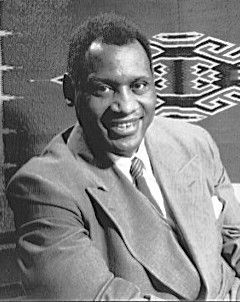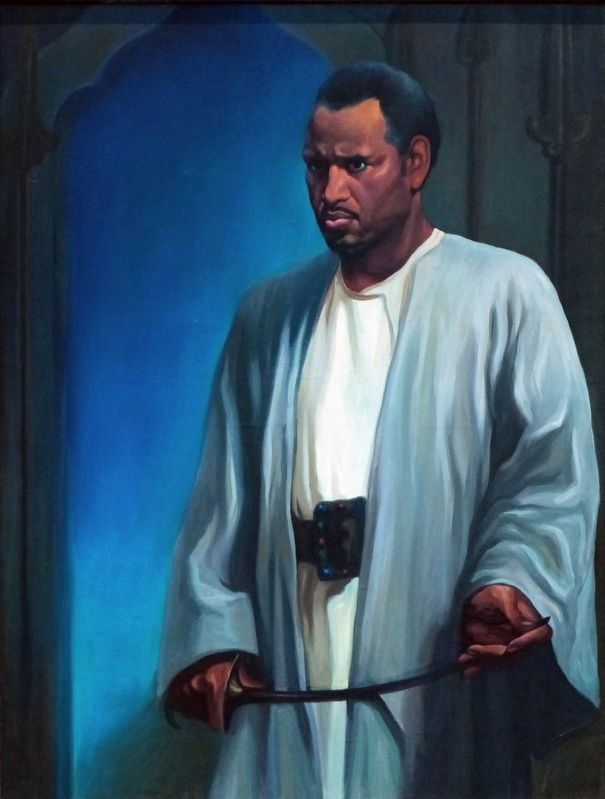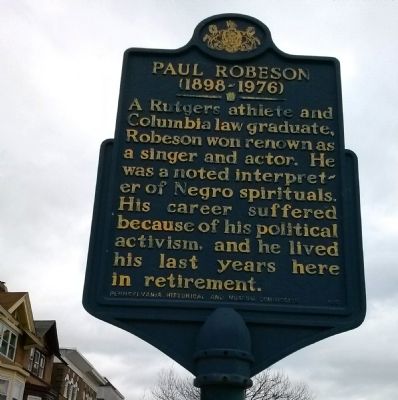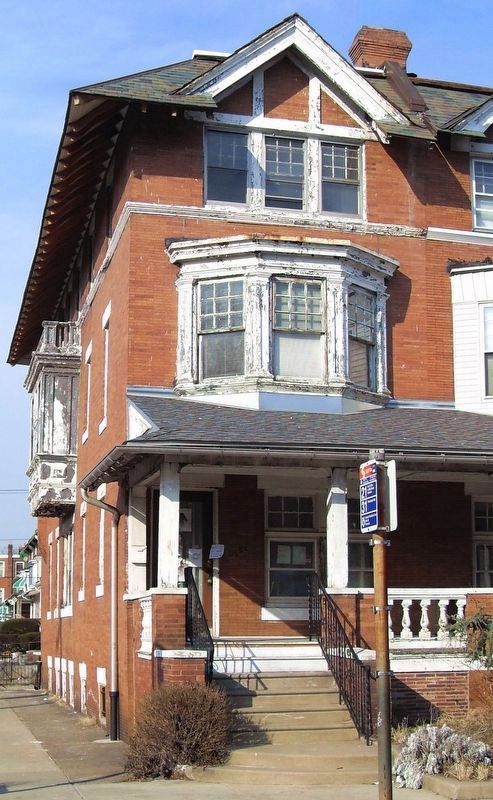University City in Philadelphia in Philadelphia County, Pennsylvania — The American Northeast (Mid-Atlantic)
Paul Robeson
(1898 – 1976)
Erected 1991 by Pennsylvania Historical and Museum Commission. (Marker Number 199.)
Topics and series. This historical marker is listed in these topic lists: African Americans • Arts, Letters, Music • Entertainment • Government & Politics. In addition, it is included in the Pennsylvania Historical and Museum Commission series list.
Location. 39° 57.391′ N, 75° 13.281′ W. Marker is in Philadelphia, Pennsylvania, in Philadelphia County. It is in University City. Marker is on Walnut Street. Touch for map. Marker is at or near this postal address: 4951 Walnut Street, Philadelphia PA 19139, United States of America. Touch for directions.
Other nearby markers. At least 8 other markers are within walking distance of this marker. Ruth Plumly Thompson (approx. 0.4 miles away); American Bandstand (approx. half a mile away); Built c. 1884 (approx. half a mile away); a different marker also named Built c. 1884 (approx. half a mile away); Built c. 1895 (approx. half a mile away); Built c. 1880 (approx. half a mile away); Built c. 1904 (approx. 0.6 miles away); World War I Memorial (approx. 0.6 miles away). Touch for a list and map of all markers in Philadelphia.
More about this marker. Located in West Philadelphia.
Regarding Paul Robeson. The Robeson House (4951 Walnut Street) is the last home of Paul Robeson, the legendary African-American scholar, athlete, actor, singer and human rights activist. The house has been recognized as National Historic Landmark as well as an African-American historic site and tourist destination of both national and international importance.
Paul Robeson was born in 1898, the son of Reverend William Drew Robeson and Maria Louisa Bustill. Rev. Robeson as a teenager escaped slavery on the Underground Railroad, and later earned a theological degree, and used the pulpit to advocate for equal rights.
Paul Robeson was renowned for his rich baritone voice, superb acting ability, and passionate zeal for racial and human justice. He was a gifted student and athlete while attending Rutgers University in New Jersey. He won honors in debating and oratory and graduated from Columbia Law School.
He left the practice of law to pursue a career in singing and acting. Robeson performed on Broadway, and is noted for his leading roles in Othello and Eugene O'Neill's play, Emperor Jones, and his stunning rendition of the song -Ole Man River- in the musical Showboat.
In 1934, he visited the Soviet Union, where he felt fully accepted as a black artist. During World War II, he entertained troops and sang battle songs on the radio. Despite his war efforts, he was labeled "subversive" by McCarthyites who were wary of his earlier trip to the Soviet Union, his support of the 1947 St. Louis picketing against segregation of black actors, and a Panama effort to organize the mostly-black Panamanian workers.
Robeson received death threats from the Ku Klux Klan while campaigning for the Progressive Party candidate in the 1948 presidential election. In March 1950, NBC barred Robeson from appearing on a television show with Eleanor Roosevelt. Concert halls closed their doors to him, and his records began to disappear from stores. Finally, the U.S. State Department canceled his passport. Robeson sued and the case went to the Supreme Court. After eight years and an international outcry, his passport was returned.
During the 1960s and 1970s, dozens of prominent leaders and world-renown performers visited the classic, 1911 row house in the Walnut Hill community of West

Gordon Parks, via Wikipedia Commons, June 1942
3. Paul Robeson
American actor, athlete, bass-baritone concert singer, writer, civil rights activist, Spingarn Medal winner, and Stalin peace prize laureate. Crop of a photograph in the Farm Security Administration - Office of War Information Photograph Collection at the Library of Congress Prints and Photographs Division.
Related markers. Click here for a list of markers that are related to this marker.
Also see . . .
1. Paul Robeson: The Renaissance Man. (Submitted on January 20, 2014, by Kathleen Weber of Upper Darby, Pennsylvania.)
2. Paul Robeson Biography. (Submitted on January 20, 2014, by Kathleen Weber of Upper Darby, Pennsylvania.)
3. Paul Robeson: A Brief Biography. (Submitted on January 22, 2017, by William Fischer, Jr. of Scranton, Pennsylvania.)
4. What Paul Robeson Said. (Submitted on January 22, 2017, by William Fischer, Jr. of Scranton, Pennsylvania.)
Additional keywords. Retirement, singer, actor

Photographed By Allen C. Browne, July 22, 2017
4. Paul Robeson
This 1944 portrait of Paul Robeson playing Othello by Betsy Graves Reyneau hangs in the National Portrait Gallery in Washington, DC.
“Paul Robeson's appearance in the title role in The Emperor Jones catapulted him to stardom in 1925, and his popularity soared with a 1930 Othello that ran for nearly three hundred performances. He is perhaps best known for his portrayal of Joe in both the stage and movie versions of Show Boat, singing ‘Ol' Man River.’ He stopped making films in 1942, explaining, ‘The industry is not prepared to permit me to portray the life or express the living interests, hopes, and aspirations of the struggling people from whom I come.’ Robeson's left-wing sentiments became a focal point of anti-Communism in the postwar era, and his passport was revoked in 1950. His American career largely came to an end. With the return of his passport in 1958 after a court battle, he attempted to revitalize his career, but illness and exhaustion led to a life of seclusion during his latter years.” -- National Portrait Gallery
“Paul Robeson's appearance in the title role in The Emperor Jones catapulted him to stardom in 1925, and his popularity soared with a 1930 Othello that ran for nearly three hundred performances. He is perhaps best known for his portrayal of Joe in both the stage and movie versions of Show Boat, singing ‘Ol' Man River.’ He stopped making films in 1942, explaining, ‘The industry is not prepared to permit me to portray the life or express the living interests, hopes, and aspirations of the struggling people from whom I come.’ Robeson's left-wing sentiments became a focal point of anti-Communism in the postwar era, and his passport was revoked in 1950. His American career largely came to an end. With the return of his passport in 1958 after a court battle, he attempted to revitalize his career, but illness and exhaustion led to a life of seclusion during his latter years.” -- National Portrait Gallery
Credits. This page was last revised on February 2, 2023. It was originally submitted on January 20, 2014, by Kathleen Weber of Upper Darby, Pennsylvania. This page has been viewed 1,015 times since then and 34 times this year. It was the Marker of the Week January 22, 2017. Photos: 1. submitted on January 20, 2014, by Kathleen Weber of Upper Darby, Pennsylvania. 2, 3. submitted on January 21, 2017. 4. submitted on October 10, 2017, by Allen C. Browne of Silver Spring, Maryland. • Bill Pfingsten was the editor who published this page.

